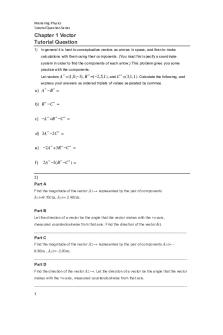Tutorial 1 - Bone Markings (Student\'s version) PDF

| Title | Tutorial 1 - Bone Markings (Student\'s version) |
|---|---|
| Author | Wayne Kwan |
| Course | Anatomy and Physiology for Sport and Exercise |
| Institution | Edinburgh Napier University |
| Pages | 2 |
| File Size | 153.2 KB |
| File Type | |
| Total Downloads | 62 |
| Total Views | 141 |
Summary
Tutorial 1 - Bone Markings (Student's version) for tutorial...
Description
Skeletal System (Introduction) Activity 1A – Bone Markings Marking Articulations
Description An area where two bones are attached for the purpose of motion of body parts. A rounded, prominent extension of bone that forms part of a joint. It is separated from the shaft of the bone by the neck. The head is usually covered in hyaline cartilage inside of a synovial capsule, as it is the main articulating surface with the adjacent bone, together forming a "balland-socket" joint.
Examples Joints - ball and socket joint, hinge joint, condyloid joint
Bone expansion carried on a narrow neck
Part of joint formation
Facet
A small smooth area on a bone or other firm structure, usually an articular surface covered in life with articular cartilage
The bone area that house the disc in the spine
Condyle
Refers to a large prominence which often provides structural support to the overlying hyaline cartilage. It bares the brunt of the force exerted from the joint.
The bottom part of the long bone (Only femur, it seems absent from humerus)
Head
Process
Rounded articular projection; often articulates with a corresponding fossa. Any bony prominence
Tubercle
Small rounded projection or process
Tuberosity
Large rounded projection, maybe roughened
Crest
Narrow ridge of bone, usually prominent
Fossa
Hollow indent area; shallow, basinlike depression in a bone,
Top part of any long bone
Side of the skull, under the eye socket (lateral) On the side, of a humerus
Mid part (Thick) of the humerus, usually known as the deltoid humerus Top of the hip bone
Back of the skull, the pelvis bone
often serving as an articular surface with a condyle Foramen
Round or oval opening through a bone
Eye socket
Sinus
Cavity within a bone, filled with air and lined with mucous membrane
Around the nose area, above and to the side
Activity 1B – Bone Features Identify the markings in the above table on the skeletons below. An example has been given to you. Self note 2 Projections that are sites of muscle and ligament attachments. Surfaces that help to form joints – Head, Facet, Condyle Head
Tubercle
Depressions and openings – For passage of blood vessels Sinus
Process Tuberosity
Foramen
Condyle Note, most likely the one on the left is a femur bone, the one on the right is a humerus bone
Crest
Facet (The flat part)
Fossa...
Similar Free PDFs

Full Tutorial - pdf version
- 91 Pages

MSproject Tutorial-Final Version
- 61 Pages

Tutorial - 221214 - students
- 5 Pages

Skeletal system 1: bone tissue
- 2 Pages

Bone disorders - Lecture notes 1
- 14 Pages

Bone Coloring
- 1 Pages
Popular Institutions
- Tinajero National High School - Annex
- Politeknik Caltex Riau
- Yokohama City University
- SGT University
- University of Al-Qadisiyah
- Divine Word College of Vigan
- Techniek College Rotterdam
- Universidade de Santiago
- Universiti Teknologi MARA Cawangan Johor Kampus Pasir Gudang
- Poltekkes Kemenkes Yogyakarta
- Baguio City National High School
- Colegio san marcos
- preparatoria uno
- Centro de Bachillerato Tecnológico Industrial y de Servicios No. 107
- Dalian Maritime University
- Quang Trung Secondary School
- Colegio Tecnológico en Informática
- Corporación Regional de Educación Superior
- Grupo CEDVA
- Dar Al Uloom University
- Centro de Estudios Preuniversitarios de la Universidad Nacional de Ingeniería
- 上智大学
- Aakash International School, Nuna Majara
- San Felipe Neri Catholic School
- Kang Chiao International School - New Taipei City
- Misamis Occidental National High School
- Institución Educativa Escuela Normal Juan Ladrilleros
- Kolehiyo ng Pantukan
- Batanes State College
- Instituto Continental
- Sekolah Menengah Kejuruan Kesehatan Kaltara (Tarakan)
- Colegio de La Inmaculada Concepcion - Cebu









